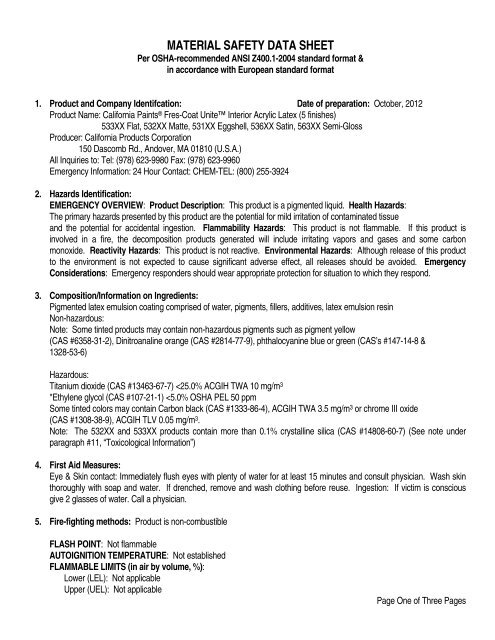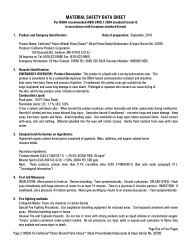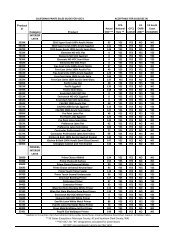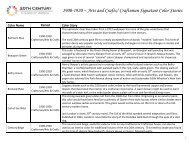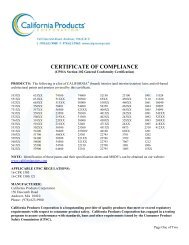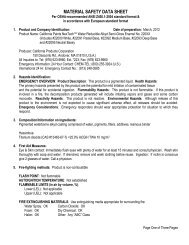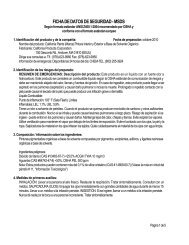MATERIAL SAFETY DATA SHEET - California Paints
MATERIAL SAFETY DATA SHEET - California Paints
MATERIAL SAFETY DATA SHEET - California Paints
You also want an ePaper? Increase the reach of your titles
YUMPU automatically turns print PDFs into web optimized ePapers that Google loves.
<strong>MATERIAL</strong> <strong>SAFETY</strong> <strong>DATA</strong> <strong>SHEET</strong><br />
Per OSHA-recommended ANSI Z400.1-2004 standard format &<br />
in accordance with European standard format<br />
1. Product and Company Identifcation: Date of preparation: October, 2012<br />
Product Name: <strong>California</strong> <strong>Paints</strong> ® Fres-Coat Unite Interior Acrylic Latex (5 finishes)<br />
533XX Flat, 532XX Matte, 531XX Eggshell, 536XX Satin, 563XX Semi-Gloss<br />
Producer: <strong>California</strong> Products Corporation<br />
150 Dascomb Rd., Andover, MA 01810 (U.S.A.)<br />
All Inquiries to: Tel: (978) 623-9980 Fax: (978) 623-9960<br />
Emergency Information: 24 Hour Contact: CHEM-TEL: (800) 255-3924<br />
2. Hazards Identification:<br />
EMERGENCY OVERVIEW: Product Description: This product is a pigmented liquid. Health Hazards:<br />
The primary hazards presented by this product are the potential for mild irritation of contaminated tissue<br />
and the potential for accidental ingestion. Flammability Hazards: This product is not flammable. If this product is<br />
involved in a fire, the decomposition products generated will include irritating vapors and gases and some carbon<br />
monoxide. Reactivity Hazards: This product is not reactive. Environmental Hazards: Although release of this product<br />
to the environment is not expected to cause significant adverse effect, all releases should be avoided. Emergency<br />
Considerations: Emergency responders should wear appropriate protection for situation to which they respond.<br />
3. Composition/Information on Ingredients:<br />
Pigmented latex emulsion coating comprised of water, pigments, fillers, additives, latex emulsion resin<br />
Non-hazardous:<br />
Note: Some tinted products may contain non-hazardous pigments such as pigment yellow<br />
(CAS #6358-31-2), Dinitroanaline orange (CAS #2814-77-9), phthalocyanine blue or green (CAS’s #147-14-8 &<br />
1328-53-6)<br />
Hazardous:<br />
Titanium dioxide (CAS #13463-67-7)
Page 2: MSDS for <strong>California</strong> <strong>Paints</strong> Fres-Coat Unite Interior Acrylic Latex (5 finishes)<br />
FIRE EXTINGUISHING <strong>MATERIAL</strong>S: Use extinguishing media appropriate for surrounding fire<br />
Water Spray: OK Carbon Dioxide: OK<br />
Foam: OK<br />
Dry Chemical: OK<br />
Halon: OK<br />
Other: Any “ABC” Class<br />
6. Accidental release measures:<br />
Personal precautions: Do not get in eyes. Do not take internally. Avoid skin contact. Prevent prolonged or repeated<br />
breathing of vapor or spray mists. Keep unnecessary people away. Floor may be slippery, use care to avoid falling. Dike<br />
and contain material with inert material (e.g. earth, sand). Transfer liquid and contaminated diking material to separate<br />
containers for disposal. Environmental precautions: Keep spills and cleaning run-offs out of municipal sewers and open<br />
bodies of water. Comply with local, national and state regulations.<br />
7. Handling and Storage:<br />
Maximum storage temperature 60°C, minimum 2°C. Keep closure tight and containers upright to prevent<br />
leakage. Precautionary labeling: KEEP FROM FREEZING". Product is non-combustible.<br />
8. Exposure Controls and Personal Protection:<br />
General protection and hygienic measures: Avoid contact with skin. Do not get in eyes. Do not take internally. Avoid<br />
breathing vapors or spray mists. Use in well-ventilated areas. Hand/skin protection: Wear neoprene or rubber gloves to<br />
prevent skin contact. Wash hands before eating, smoking or using the wash room. Food or beverages should not be<br />
consumed anywhere this product is handled or stored. Respiratory protection: None required if good ventilation is<br />
maintained. Wear respirator suitable for concentrations and of contaminants encountered. Use approved<br />
chemical/mechanical filters designed to remove particulates in open and restricted ventilation areas. Use approved airline<br />
type respirators or hoods in confined areas. Eye/face protection: Use approved safety eyewear including side shields,<br />
chemical goggles and face shields.<br />
9. Physical and Chemical Properties:<br />
Forms: Viscous liquid, slight ammoniacal odor<br />
Density: Varies with product<br />
Solubility in water: Complete colloidal dispersion<br />
10. Stability and Reactivity:<br />
Stability: Hazardous polymerization will not occur. Stable. Hazardous reactions: Avoid contact with strong oxidizing agents<br />
(e.g. nitric acid, permanganates), etc.<br />
11. Toxicological Information:<br />
The 532XX and 533XX products contain more that 0.1% crystalline silica (CAS #14808-60-7) which has been classified by<br />
IARC as a Class I carcinogen. Normal application procedures pose no hazard since the silica is wet and encapsulated, but<br />
grinding or sanding dried films may yield respirable silica dusts. Control exposures to less than 0.1 mg per cubic meter of<br />
air using approved dust filter respirators. Skin contact: Prolonged or repeated contact with product may cause slight skin<br />
irritation. Impervious gloves should be worn if prolonged skin contact is likely.<br />
12. Ecological Information:<br />
Well-diluted product would have no environmental consequences. Less than 5% ethylene glycol present in this product<br />
yields the following environmental fate considerations: Ethylene glycol is 100% volatile. Once volatilized it will react in the<br />
atmosphere with hydroxyl radicals with a half-life on about 1 day. For accidental spills, note that ethylene glycol in typical<br />
river water at 20°C was found to completely degrade in 3 days. At temperatures of 8°C, degradation occurred in 7 days.<br />
Toxicity to fish: LD50 Carrasisus auratus (goldfish) greater than 5,000 gl/L/24 hour. Modified ASTM D 1345.<br />
Algea:(Chlorella pyrenoidosa) 180,000 mg/L toxic.
Page Two of Three Pages<br />
Page 3: MSDS for <strong>California</strong> <strong>Paints</strong> Fres-Coat Unite Interior Acrylic Latex (5 finishes)<br />
13. Disposal considerations:<br />
The coating and any contaminated diking material should be thoroughly air dried and collected into drums. The drums<br />
should then be sealed and properly labeled with waste designation and land filled or incinerated according to local and<br />
national regulations.<br />
14. Transportation Information:<br />
U.S. Department of Transportation Hazard Class: "Not Regulated"<br />
15. Regulatory Information:<br />
*This chemical is subject to the reporting requirements of Section 313 of the Emergency Planning and Community-Right-<br />
To-Know Act of 1986 and of 40 CFR 372.<br />
SARA TITLE III: Section 311/312 Categorizations (40CFR370): This product is not a hazardous chemical under 29CFR<br />
1910.1200, and therefore is not covered by Title III of SARA.<br />
CALIFORNIA SAFE DRINKING WATER AND TOXIC ENFORCEMENT ACT (PROPOSITION 65): Components of this<br />
product are on the <strong>California</strong> Proposition 65 lists.<br />
CERCLA INFORMATION (40CFR302.4): Releases of this material to air, land, or water are not reportable to the National<br />
Response Center under the Comprehensive Environmental Response, Compensation, and Liability Act (CERCLA) or to<br />
state and local emergency planning committees under the Superfund Amendments and Reauthorization Act (SARA) Title<br />
III Section 304.<br />
U.S. TOXIC SUBSTANCES CONTROL ACT (TSCA): All components of this product are in compliance with the inventory<br />
listing requirements of the U.S. Toxic Substances Control Act (TSCA) Chemical Substance Inventory.<br />
Information on the maximum volatile organic compound (VOC) content of individual products appears on product labels.<br />
16. Other Information:<br />
Note: Per 29CFR 1910.1200 (g) (2) (1) (C) (2), only hazardous substances present in excess of 1.0% by weight (or 0.1%<br />
for carcinogens) must be listed on an MSDS.<br />
To comply with New Jersey DOH Right-To-Know labeling law (NJAC 8:59 – 5.1 & 5.2)<br />
HMIS HAZARD RATING<br />
Health 1 Flammability 0 Physical<br />
Hazard 0<br />
HAZARD INDEX<br />
Personal<br />
Protection A<br />
0=Minimal, 1=Slight, 2=Moderate, 3=Serious, 4=Severe<br />
PERSONAL PROTECTION CODE:<br />
A=Safety glasses<br />
Warning! If you scrape, sand or remove old paint, you may release lead dust. LEAD IS TOXIC. EXPOSURE TO LEAD DUST CAN CAUSE<br />
SERIOUS ILLNESS, SUCH AS BRAIN DAMAGE, ESPECIALLY IN CHILDREN. PREGNANT WOMEN SHOULD ALSO AVOID<br />
EXPOSURE. Wear a NIOSH-approved respirator to control lead exposure. Clean up carefully with a HEPA vacuum and wet mop. Before you<br />
start, find out how to protect yourself and your family by contacting the National Lead Information Hotline at 1-800-424-LEAD (5323) or log on<br />
to: www.epa.gov/lead
Page Three of Three Pages


